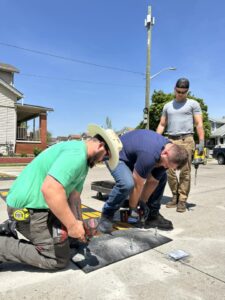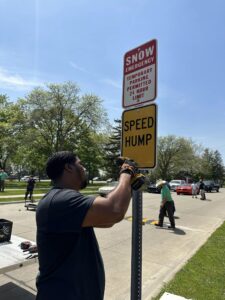DEARBORN — On Thursday, May 11, Dearborn Mayor Abdullah H. Hammoud announced that the city will install speed humps in three high-traffic areas as part of a comprehensive effort to curb speeding and reckless driving in its neighborhoods.
“Dearborn residents have been clear from day one: We need to make our roads safer,” Hammoud said. “This program is about thinking beyond reactive measures and taking a preventative approach. These persistent public health and safety issues require dynamic, innovative and multi-pronged strategies that lead with feedback from those directly affected.”

Dearborn Department of Public Works employees install a rubber speed hump on Hemlock St., between Calhoun and Bingham, as part of a comprehensive effort to curb speeding and reckless driving in Dearborn neighborhoods. – Photos courtesy of the Dearborn Department of Communications.
According to Hammoud, road safety consistently ranks as the top priority for residents. The speed humps will be constructed on city-owned roads, as Dearborn does not have jurisdiction over major state and county roads that run through the city.
Speaking over Facebook Live from one of the pilot sites, Hammoud stressed that the program is part of a broader strategy to improve quality of life, address public safety and drive responsible community development.
Shortly after taking office, Mayor Hammoud secured a $200,000 allocation for new traffic calming measures and fund new initiatives such as speed humps.
Hammoud also convened a task force to research and advise on traffic calming strategies to enhance neighborhood road safety and to treat road safety as a public health issue.
Led by Dearborn Police Sgt. Andrew Galuszka, the Traffic Calming Task Force includes representatives from various departments across the city, including Public Health, Public Works, Community Relations and others. The Task Force’s mission is to enhance road safety from all angles, from the engineering of the city’s roads to enforcement and community messaging campaigns. It is also responsible for aggregating all feedback from the community and determining how to allocate resources in a way that is directly responsive to that feedback.

Dearborn is testing speed humps in residential area to combat speeding and reckless driving.
“Our task force reached a consensus to place speed humps near some of our busiest parks,” Galuszka said. “This pilot will allow for a period of time to gather data and feedback about the use of speed humps as the overall traffic calming program continues to develop. The process of developing a traffic calming program is dynamic and evolving.”
After extensive research on best practices from other communities, the Task Force recommended a trial program to install rubber speed humps on three road segments known for being sources of frequent traffic complaints and that have other advantages for data and feedback collection. Rubber material was chosen based on cost and ease of installation and removal.
Community-driven strategy
The three locations will be part of the initial test and more could follow based on the results.
The initial pilot locations are:
- Hemlock St. adjacent to Hemlock Park;
- Lapeer St. adjacent to Lapeer Park and
- Silvery Lane adjacent to Levagood Park.
- They are not in close proximity to one another, allowing for a greater number of residents who can observe them and provide feedback;
- Each location is adjacent to a park and known to be a source of traffic complaints;
- Homes are not facing the areas where the speed humps will be located and
- There will not be anticipated disruption to public services, deliveries or parking.
During the trial period, city officials will collect and analyze data on public safety effects, traffic speed, traffic volume and other indicators.
Feedback from the community and city departments is essential to the future development of the project, according to Hammoud. The administration is asking residents to visit the pilot sites, and provide input and feedback on where the city should install future speed humps using this survey: forms.gle/SPPdNiQb29Mi6gLU8






Leave a Reply